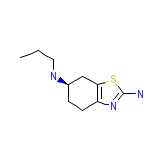Pramipexol




Categoria
Pramipexol Nombres de marca, Pramipexol Analogos
Pramipexol Marca los nombres de mezcla
Pramipexol Formula quimica
Pramipexol RX enlace
Pramipexol FDA hoja
Pramipexol MSDS (hoja de seguridad de materiales)
Pramipexol Sintesis de referencia
Pramipexol Peso molecular
Pramipexol Punto de fusion
Pramipexol H2O Solubilidad
Pramipexol Estado
Pramipexol LogP
Pramipexol Formas de dosificacion
Pramipexol Indicacion
Pramipexol Farmacologia
Pramipexol Absorcion
Pramipexol Toxicidad
Pramipexol Informacion de Pacientes
Patients should be instructed to take MIRAPEX only as prescribed.
Patients should be informed that hallucinations can occur and that the elderly are at a higher risk than younger patients with Parkinson 's disease.
Patients may develop postural (orthostatic) hypotension, with or without symptoms such as dizziness, nausea, fainting or blackouts, and sometimes, sweating. Hypotension may occur more frequently during initial therapy. Accordingly, patients should be cautioned against rising rapidly after sitting or lying down, especially if they have been doing so for prolonged periods and especially at the initiation of treatment with MIRAPEX.
Patients should be advised that MIRAPEX may cause somnolence and that they should neither drive a car nor operate other complex machinery until they have gained sufficient experience on MIRAPEX to gauge whether or not it affects their mental and/or motor performance adversely. Because of the possible additive sedative effects, caution should also be used when patients are taking other CNS depressants in combination with MIRAPEX.
Because the teratogenic, potential of pramipexole has not been completely established in laboratory animals, and because experience in humans is limited, patients should be advised to notify their physicians if they become pregnant or intend to become pregnant during therapy.
Because of the possibility that pramipexole may be excreted in breast milk, patients should be advised to notify their physicians if they intend to breast-feed or are breast-feeding an infant.
If patients develop nausea, they should be advised that taking MIRAPEX with food may reduce the occurrence of nausea.














